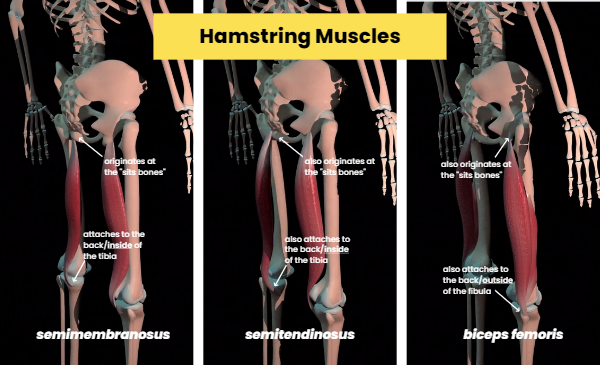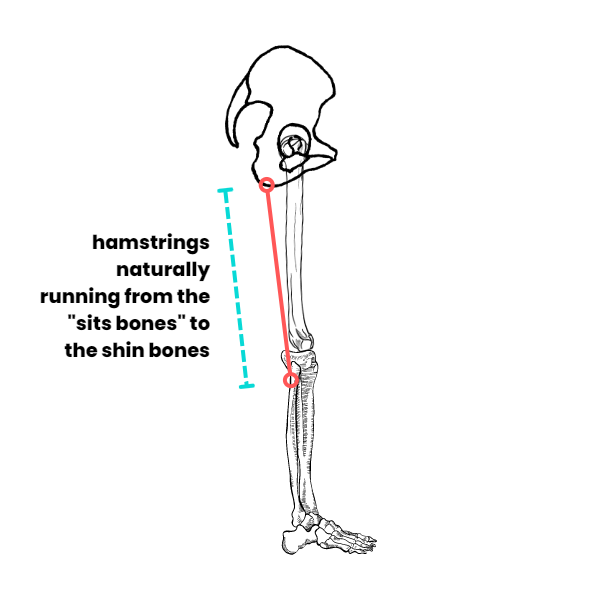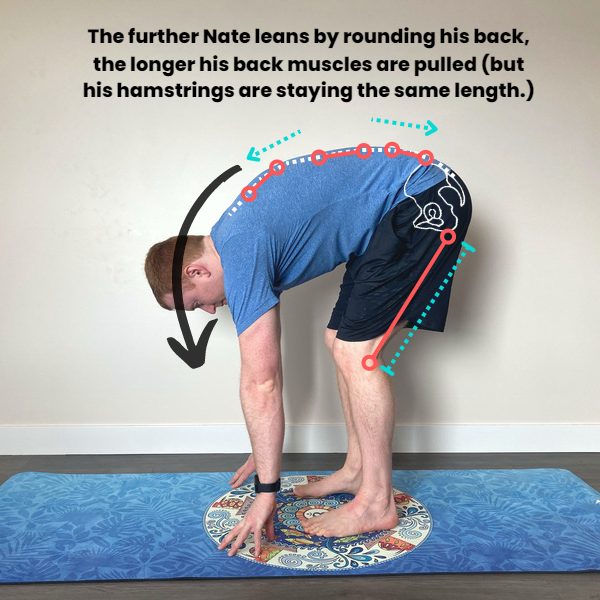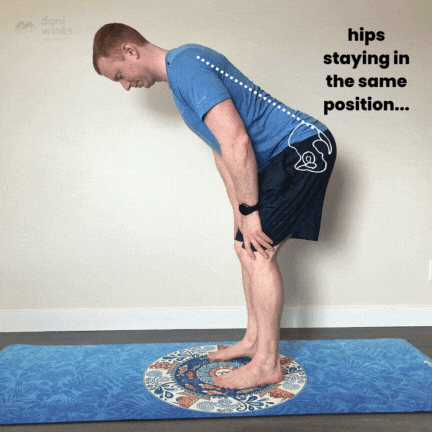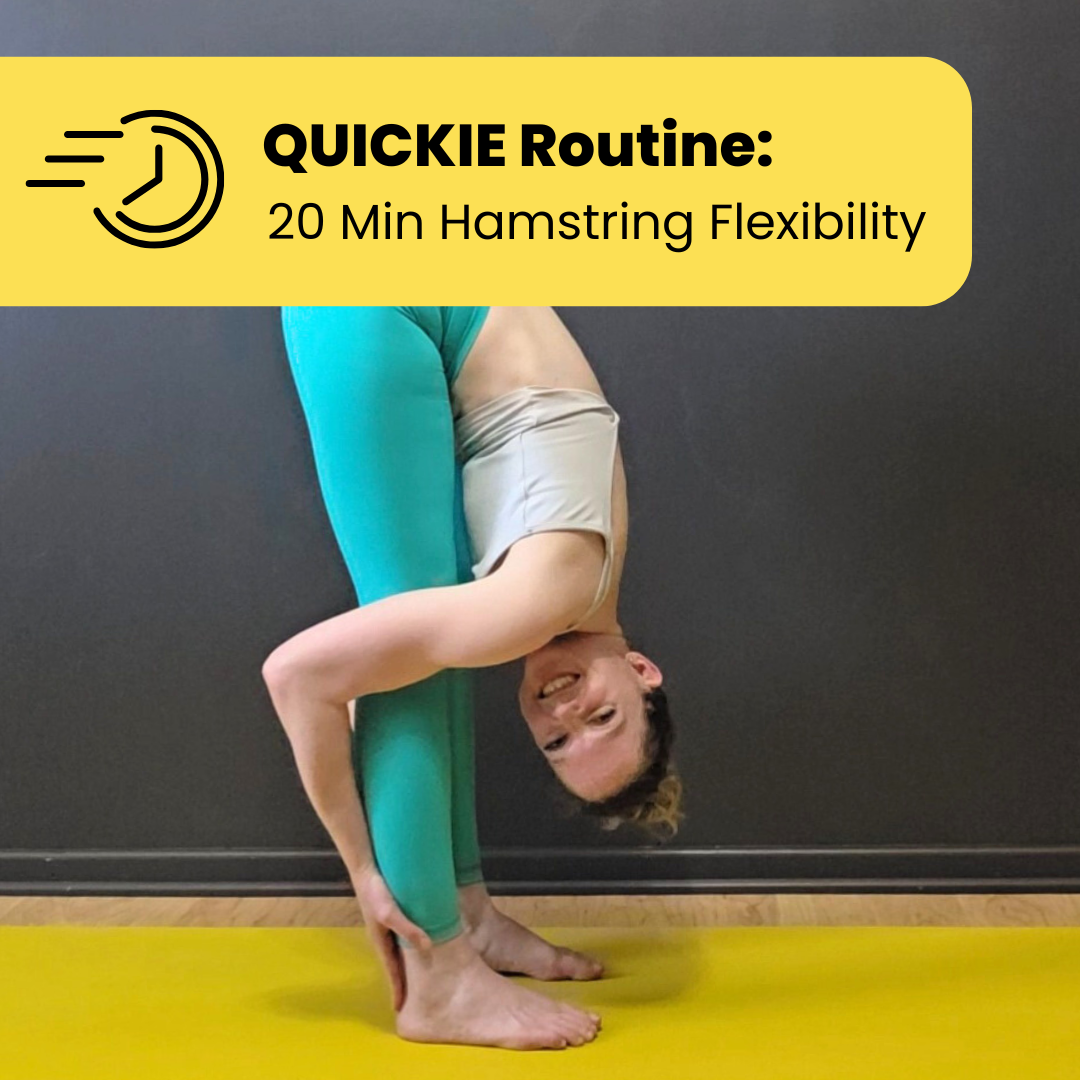Is it OK to Round Your Back in a Forward Fold?
Is it OK to Round Your Back in a Forward Fold?
Like with most flexibility-related questions, the answer is “it depends.”
Your choice for posture for your forward fold really depends on your goals.
If your goal is to stretch your hamstrings…
If you’re using a forward fold as a hamstring stretch, it’s often preferred to keep the back flat. Why? Because this ensures that all of the forward fold is appropriately coming from our hips and not our back.
Our hamstrings are actually a group of three different muscles that run from “sits bones” at the bottom of our pelvis to the back inside/outside of our shin bones under the knee:
A “proper” flat-back forward fold requires us lean forwards by rotating our hip bones forwards in space (aka anteriorly tilt the pelvis), which is the action that is literally pulling the hamstrings longer (into a stretch!):
Hamstrings when standing normally
Hamstrings lengthening when hip bones rotate forwards (forward folding)
Oftentimes when students have tight hamstrings (and/or weak hip flexors, the muscles on the front of the hips), there’s a tendency to lean forwards by letting the back round because that’s easier for our body. But if all we’re doing is rounding our back and not actually rotating our hip bones, that means no matter how far we reach with our chest, the hamstring stretch will remain pretty minimal.
In the images below, you can see how much farther Nate is able to reach when he rounds his back (he can easily touch his toes). But if you watch the position of his pelvis, it’s in the exact same position in both “stretches,” meaning he’s not getting any more of a hamstring stretch when he reaches farther:
Now that doesn't mean you can't get a deep hamstring stretch with your back rounded, BUT most students benefit from trying to isolate the target area they're trying to stretch (the hamstrings) to avoid letting other joints / muscle groups compensate for the that area.
A great modification for students with tighter hips is to bend your knees, which can make the hamstring stretch more comfortable, which in turn makes it easier to keep the back flat. Over time, you can work on straightening the knees.
Here’s what that looks like with Nate (who, if you can’t tell, has some hella tight hamstrings!):
This is as far as Nate can (currently) forward fold while keeping his back flat. To him, this feels like an intense hamstring stretch.
Now notice how much farther Nate can forward fold when bending his knees. This is still a deep hamstring stretch, but easier for him to hold with “good” (flat back) form.
So don’t worry if when you work on your flat-back forward folds they look suspiciously more like “barely leaning forwards” than actually “folding” - all that really matters is that you’re feeling a stretching sensation in the back of your thighs (and as always, without pushing anything to the point of pain!).
If your goal is to stretch your entire posterior chain…
If you’re looking to use a forward fold as more of a full back-body stretch, stretching the backside of your hips and your back, then letting your back round is a better variation. Rounding your back allows a nice stretch in your erector spinae, the long muscles running alongside each side of your spine that help arch your back.
The one caveat I’ll give here is that for students with very tight hips, such as those who can’t sit up with a flat back when they’re legs are extended in front of them on the floor, there is a chance that letting your back round can put too much pressure on your lumbar spine (low back), leading to pain. If that’s the case for you, I’d suggest modifying your forward fold with any of the following:
adding a slight knee bend to your forward fold (or a more generous knee bend, turning it into more of a ragdoll forward fold). For context, Nate (from the pictures above) virtually always practices his hamstring stretches with a pretty visible bend in his knees
placing your hands on your thighs (or a chair in front of you) for support can also help take weight out of the low back and make it more comfortable to hold
OR you can choose to work on your back and your hip flexibility separately. That coule mean working on flat-back forward fold variations (see above) to work on your hamstring flexibility, and then adding additional back-rounded stretches like Child’s Pose or Cat-Cow. Poses like those allow you to stretch your back without the bodyweight stress that a standing or seated forward fold can sometimes put on our low back (as it’s asked to support the weight of our entire upper body when we lean forwards).
If your goal is to touch your toes…
Being able to touch your toes is a functional movement and a great baseline flexibility goal for general health because it helps ensure you have the hip flexibility to do basic tasks like easily picking things up off the floor, tying your shoes, etc. (Another great functional hip flexibility goal to work towards or maintain as you age is being able to stand up from sitting on the floor without using your hands - but that’s a topic for another blog post!).
As you can see, most of this toe touch flexibility is coming from Nate’s back - which is not necessarily a bad thing, it’s just how his body is currently working in this movement pattern.
Because our body will try to use the most joints to “help” make the movement easy, it’s natural (and OK!) to let your back round to be able to touch your toes. But if you look at a photo of yourself performing a toe touch and notice that most of the movement is coming from your back, it may be helpful to continue to work on your hamstring flexibility (with some flat-back stretches) to make this movement more comfortable in the long run.
So for students who have a toe-touch goal purely as a milestone to measure flexibility progress, I’d suggest two goals to work towards:
Able to touch toes (rounded back is OK)
Able to touch toes with a flat back
Or if you’re really looking to challenge your hamstrings, this can further become:
Able to place palms on the floor in a forward fold (rounded back is OK)
Able to place palms on the floor with a flat back
To Recap: Rounding the back is not “wrong,” but it may not be the most beneficial way for you to stretch
Even if your goal is just to be able to functionally touch your toes (which you can do with a round in your back!), you may still benefit by including some stretches/drills to improve your hamstring flexibility where your back isn’t allowed to jump in and “help.”
And if you’re someone’s totally on board with doing more flat back work, but finds it so damn hard to not round - stay tuned for my next post where I’ll talk about different ways to train that “flat back” position!

